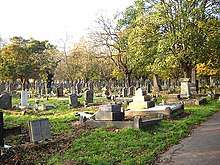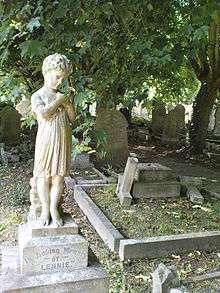Tottenham Cemetery
Tottenham Cemetery is a large burial ground in Tottenham in the London Borough of Haringey, in north London, England. It was opened in 1858 by the Tottenham Burial Board to replace the churchyard of All Hallows' Church, Tottenham which had closed the previous year. The original five-acre site was not entirely consecrated, with two acres designated for non-Church of England burials.

Chapels
The cemetery contains two original chapels, one built for Anglican services and one for other denominations. The buildings were designed by the architect George Pritchett in an early Gothic style. They were constructed primarily of Kentish ragstone, but include Bath stone dressings.[1]
War graves
The cemetery contains the Commonwealth war graves of 293 service personnel of World War I, most of whom are buried in a war graves plot on the western side of the cemetery, backed by a screen wall listing those buried in the plot and elsewhere in the cemetery whose graves could not be individually marked. Most of the 212 war graves from World War II are scattered in the cemetery but 30 of them lie in a small plot facing the World War I plot. Those whose graves could not be individually marked are listed on supplementary panels on the screen wall.[2]
Notable burials

- Robert Brett (1808–1874), an English surgeon and writer of devotional books, involved with the tractarian movement.
- John Eliot Howard (11 November 1807 – 22 November 1883), an English chemist of the nineteenth century, who conducted pioneering work with the development of quinine[3]
- William Butterfield (7 September 1814 – 23 February 1900), a Gothic Revival architect (tomb now a listed monument)[4][5]
- Thomas Bidgood (7 October 1858 – 1 March 1925), an English conductor, composer and arranger (buried in an unmarked grave)
- Alfred Edward Durrant VC ISM (4 November 1864 – 29 March 1933), an English recipient of the Victoria Cross[6]
- Edward Henry "Ted" Willis, Baron Willis (13 January 1914 - 22 December 1992), a British playwright, novelist and screenwriter who was also politically active in support of the Labour Party[7]
Sources
- Fred Fisk The History of the Ancient Parish of Tottenham in the County of Middlesex, from early Druidical times, B.C. to A.D. 1923 (Tottenham, 1923), pp. 145–6, 340
- Hugh Meller & Brian Parsons, London Cemeteries: an Illustrated Guide and Gazetteer, 4th edition (The History Press, 2008)
References
- London Gardens Online: Tottenham Cemetery, London Parks and Gardens Trust, March 1st 2011
- CWGC Cemetery report.
- G. S. Boulger, ‘Howard, John Eliot (1807–1883)’, rev. Max Satchell, Oxford Dictionary of National Biography, Oxford University Press, 2004; online edn, Jan 2010.
- Historic England. "Tomb of William Butterfield in Tottenham Cemetery (Grade II) (1084329)". National Heritage List for England. Retrieved 15 July 2018.
- London Gardens Online: Tottenham Cemetery, London Parks and Gardens Trust, March 1st 2011
- "Tottenham Cemetery". Find a Grave. Retrieved 3 September 2010.
- "Tottenham Cemetery". Find a Grave. Retrieved 7 May 2015.